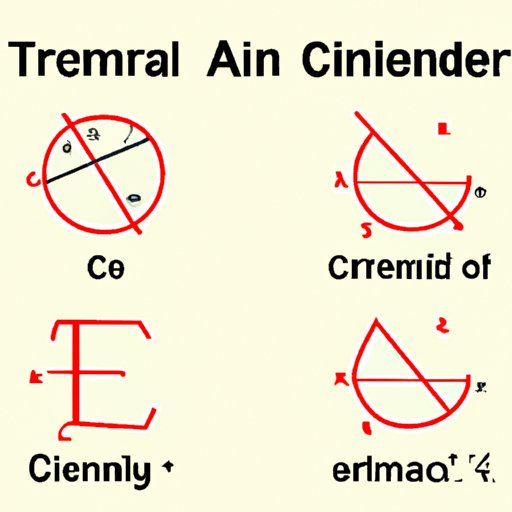
I. Introduction
Trigonometry is an essential component of mathematics that’s widely used in science and engineering. One of the fundamental concepts in trigonometry is coterminal angles, which are key to solving many trigonometric problems. In this article, we’ll explore the definition of coterminal angles, how to find them, and their application in trigonometry.
II. The Fundamentals of Coterminal Angles: A Beginner’s Guide
Coterminal angles are angles that have the same initial and terminal sides. They are measured in degrees or radians and are related to the unit circle, which is a circle of radius one unit. Coterminal angles can be positive or negative depending on the direction of rotation. Positive angles are measured counterclockwise, while negative angles are measured clockwise. Understanding the basics of coterminal angles is crucial to solving trigonometric problems because it simplifies calculations.
III. Trigonometry Made Simple: How to Quickly Find Coterminal Angles
Finding coterminal angles can be achieved using simple calculations. To find a positive coterminal angle, add 360 degrees (or 2π radians). Similarly, to find a negative angle, you should subtract 360 degrees (or 2π radians). For example, if the given angle is 30°, then its positive coterminal angle is 390°, and its negative coterminal angle is -330°. Below are examples of coterminal angles for common angles:
- 45° has coterminal angles of -315° and 405°
- 60° has coterminal angles of -300° and 420°
- 90° has coterminal angles of -270° and 450°
Identifying coterminal angles can be easier by recognizing patterns in the angles. For example, 30° and 330° are coterminal angles, and 60° and 300° are coterminal angles. This means that all angles that differ by 360 degrees or multiples of 360 degrees are coterminal angles.
IV. Mastering Trigonometry: An In-Depth Explainer on Coterminal Angles
Coterminal angles have advanced concepts that are essential for mastering trigonometry. These concepts include reference angles and periodicity. Reference angles are acute angles that are formed by the terminal side of an angle and the x-axis. For example, the reference angle of 150° is 30°, and the reference angle of -210° is 30°. Periodicity is the tendency of trigonometric functions to repeat their values after specific intervals. The period of a trigonometric function is the smallest angle for which the function repeats itself.
Coterminal angles also relate to other trigonometric functions such as sine, cosine, and tangent. The values of these functions for an angle and its coterminal angles are the same.
Here’s an example: the sine of 60° is equal to the sine of 420°, which is the positive coterminal angle of 60°.
V. Coterminal Angles Demystified: A Step-by-Step Tutorial
Let’s explore another example to find coterminal angles:
Example:
Find the coterminal angles for the angle -195°
Solution:
We add 360 degrees to -195° to get a positive coterminal angle:
-195° + 360° = 165°
The negative coterminal angle can be found by subtracting 360 degrees from the original angle:
-195° – 360° = -555°
VI. Unlocking Trigonometry: Tips and Tricks to Easily Find Coterminal Angles
When finding coterminal angles, it is essential to avoid common mistakes such as confusion between degrees and radians when dealing with angles. Also, it’s beneficial to know that all angles that differ by a multiple of 2π (or 360 degrees) are coterminal angles. By recognizing patterns in angles, it’s possible to simplify calculations.
Suggested practice problems:
- Find the positive and negative coterminal angles for 240°
- Find the positive and negative coterminal angles for -45°
- Find the reference angle for 315°.
VII. Struggling with Coterminal Angles? Here’s What You Need to Know
Struggling with coterminal angles is common among students taking trigonometry courses. One of the most common difficulties is identifying patterns in coterminal angles. Another challenge is understanding the relationship between coterminal angles and other trigonometric functions such as cosine and tangent. During this struggle, it’s helpful to practice, ask questions, and seek extra resources such as online tutorials and textbooks to improve understanding.
VIII. Expert Advice: How to Efficiently Solve for Coterminal Angles
According to Anthony Smith, a mathematics professor with ten years of experience, mastering coterminal angles requires practice and understanding the concept of rotation. He advises students to review all their learned concepts, including the unit circle, periodicity, and reference angles. Smith also recommends using diagrams to visualize angles and their coterminal angles.
IX. Conclusion
Coterminal angles are essential in trigonometry and can simplify calculations. With proper understanding of coterminal angles and their applications, students can master trigonometry and excel in related fields such as engineering and science. With the step-by-step guide, tutorials, and expert advice provided in this article, we encourage readers to practice and sharpen their new skills in solving coterminal angle problems.




